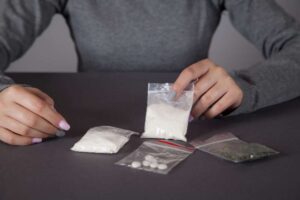As adolescents and young adults navigate the tumultuous waters of identity formation, peer pressure, and societal expectations, the allure of drugs can often be overwhelming. What starts as a seemingly harmless experiment can quickly spiral into a life-altering dependency, leaving individuals and their loved ones grappling with the devastating consequences. In this blog, we delve into the complexities of drug addiction in youth, exploring its causes, manifestations, and most importantly, strategies for prevention and intervention.
Contents
What Are the Causes Of Drug Abuse Among Youth?
 Drug abuse among youth can stem from a variety of interconnected factors, including:
Drug abuse among youth can stem from a variety of interconnected factors, including:
- Genetic Predispositions
Genetics plays a significant role in determining an individual’s susceptibility to addiction. Certain genetic variations can increase the likelihood of developing substance abuse disorders, making some youth more vulnerable than others.
- Environmental Influences
The environment in which a young person grows up can heavily influence their likelihood of experimenting with drugs. Factors such as family dynamics, socioeconomic status, exposure to trauma or violence, and peer pressure can all contribute to the initiation of drug use.
- Psychological Factors
Underlying mental health issues, such as depression, anxiety, or trauma, can drive youth towards substance abuse as a means of self-medication or coping mechanism. Additionally, personality traits like impulsivity or sensation-seeking behavior may also contribute to drug experimentation and addiction.
- Social and Peer Influence
Adolescents are particularly susceptible to the influence of their peers. Peer pressure to fit in, rebel, or experiment with drugs can be strong motivators for youth to engage in substance abuse, even if they may not have initially been inclined to do so.
- Accessibility and Availability
Easy access to drugs, whether through peers, family members, or community networks, can significantly increase the likelihood of youth experimenting with substances. And, inadequate drug education and the prevalence of drug culture in certain communities can contribute to this accessibility.
- Media and Cultural Influence
Media portrayals of drug use, whether in movies, music, or social media, can glamorize substance abuse and normalize it as a part of youth culture. This can desensitize young people to the risks and consequences associated with drug use, making it more likely for them to experiment.
Understanding these complex and interconnected causes is crucial in developing effective prevention and intervention strategies to address youth drug abuse.
What Are The Consequences Of Drug Addiction In Youth?
Drug addiction in youth can have far-reaching and profound consequences that affect every aspect of their lives.
Negative impacts
Some of the consequences include:
Physical Health Implications
Substance abuse can lead to a myriad of physical health problems, including organ damage, cardiovascular issues, respiratory problems, infectious diseases (such as HIV/AIDS or hepatitis), and an increased risk of overdose or poisoning.
Mental Health Repercussions
Drug addiction often co-occurs with mental health disorders such as depression, anxiety, bipolar disorder, or psychosis. Substance abuse can exacerbate existing mental health issues and increase the risk of developing new ones. And, leading to a cycle of self-medication and worsening symptoms.
Impaired Cognitive Functioning
Prolonged substance abuse can impair cognitive function, affecting memory, attention, decision-making, and problem-solving abilities. This can impact academic performance, employment prospects, and overall functioning in daily life.
Social and Interpersonal Problems
Drug addiction can strain relationships with family, friends, and peers. It can lead to social isolation, withdrawal from previously enjoyed activities, conflicts, and misunderstandings. Youth may also engage in risky behaviors or criminal activities to support their drug habit, further alienating them from their social support networks.
Educational and Vocational Challenges
Substance abuse can hinder academic achievement, attendance, and motivation to succeed in school. It may also limit opportunities for higher education or vocational training, affecting long-term career prospects and economic stability.
Legal Consequences
Involvement in drug-related activities can result in legal troubles, including arrests, criminal charges, and incarceration. These legal consequences can have lasting effects on a youth’s record, limiting future opportunities and perpetuating a cycle of involvement in the criminal justice system.
Financial Instability
Drug addiction is often accompanied by financial strain, as individuals may prioritize purchasing drugs over meeting basic needs such as food, shelter, or healthcare. This can lead to financial dependency, debt, homelessness, and reliance on illegal or risky means of income generation.
Risk of Overdose and Death
The use of certain drugs, particularly opioids and synthetic substances, carries a high risk of overdose. This can be fatal. Youth who engage in drug abuse are at heightened risk of accidental overdose, especially if they misuse substances or combine them with other drugs or alcohol.
These consequences underscore the urgent need for prevention, early intervention, and comprehensive treatment approaches to address youth drug addiction. By addressing the multifaceted impact of substance abuse, communities can support young people in overcoming addiction and building healthier, more fulfilling lives.
How To Treat Drug Addiction In Youth?
 Treating drug addiction in youth requires a comprehensive and multidisciplinary approach that addresses the physical, psychological, social, and environmental factors contributing to substance abuse. Some effective treatment strategies include:
Treating drug addiction in youth requires a comprehensive and multidisciplinary approach that addresses the physical, psychological, social, and environmental factors contributing to substance abuse. Some effective treatment strategies include:
1. Detoxification
For youth with severe substance dependence, detoxification may be necessary to safely manage withdrawal symptoms. Medical supervision during detox can help manage complications and ensure the individual’s safety.
2. Behavioral Therapy
Various behavioral therapies, such as cognitive-behavioral therapy (CBT), contingency management, motivational interviewing, and family therapy, are effective in treating youth drug addiction. These therapies help individuals identify and modify maladaptive thoughts, beliefs, and behaviors associated with substance abuse.
3. Medication-Assisted Treatment (MAT)
MAT combines medication with behavioral therapy to address substance use disorders. For certain addictions, such as opioid or alcohol dependence, medications like methadone, buprenorphine, or naltrexone can help manage cravings and support long-term recovery.
4. Support Groups and Peer Support
Engaging in support groups such as Narcotics Anonymous (NA) or peer support programs can provide youth with a sense of community, understanding, and accountability. Peer support can complement formal treatment by offering empathy, encouragement, and practical advice from individuals with shared experiences.
5. Dual Diagnosis Treatment
Many youth with substance use disorders also struggle with co-occurring mental health disorders. Dual-diagnosis treatment addresses both substance abuse and underlying mental health issues through integrated interventions, such as medication management, therapy, and support groups.
6. Education and Skill Building
Providing education about the effects of drugs, healthy coping strategies, and life skills training can empower youth to make informed decisions and develop alternative ways of managing stress, emotions, and peer pressure.
7. Family Involvement
Involving family members in the treatment process can enhance outcomes for youth with drug addiction. Family therapy helps improve communication, resolve conflicts, and rebuild trust and support systems within the family unit.
It’s essential for treatment approaches to be tailored to the individual needs, preferences, and circumstances of each youth, considering factors such as their age, developmental stage, cultural background, and social environment.
How Can We Prevent Drug Abuse In Youth?
Preventing drug abuse in youth requires a multifaceted approach that addresses risk factors and promotes protective factors at various levels of influence.
Practical tips
Here are additional strategies for preventing youth drug abuse:
Early Intervention Programs
Implementing early intervention programs in schools, communities, and healthcare settings can identify at-risk youth and provide them with support and resources before substance abuse becomes a problem. These programs may include screenings, counseling services, and referrals to appropriate treatment and support services.
Promotion of Positive Peer Influence
Encouraging positive peer relationships and role-modeling healthy behaviors among peers can help counteract the influence of peer pressure to engage in substance abuse. Peer-led prevention programs, mentorship initiatives, and youth empowerment activities promote positive social norms and resilience among youth.
Parental Education and Involvement
Providing parents and caregivers with education and resources on how to communicate effectively with their children about drugs, set clear expectations and boundaries, and monitor their activities can help prevent drug abuse. Parental involvement in their children’s lives fosters positive relationships. Hence, reduces the likelihood of substance abuse.
Community Mobilization and Collaboration
Mobilizing communities to take collective action against drug abuse through community-based prevention initiatives, neighborhood watch programs, and collaborations between schools, law enforcement, and healthcare providers. All of this can create supportive environments that deter drug use and promote healthy lifestyles.
Media Literacy and Critical Thinking Skills
Providing youth with media literacy education that helps them critically analyze and evaluate media messages about drugs and substance use can empower them to make informed decisions. Also, helps to resist media influences that glamorize or normalize drug abuse.
Alternative Activities and Opportunities
Offering youth a variety of alternative activities and opportunities for personal growth, skill development, and recreation, such as sports, arts, volunteering, and leadership programs, provides healthy outlets for self-expression and socialization. This helps in reducing the likelihood of turning to drugs for fulfillment or excitement.
Policy and Environmental Approaches
 Implementing policies and regulations that restrict access to drugs, limit the marketing and advertising of alcohol and tobacco products, and promote safe and drug-free environments in schools, communities, and recreational spaces can create barriers to drug abuse. Thus, reducing opportunities for youth to engage in substance use.
Implementing policies and regulations that restrict access to drugs, limit the marketing and advertising of alcohol and tobacco products, and promote safe and drug-free environments in schools, communities, and recreational spaces can create barriers to drug abuse. Thus, reducing opportunities for youth to engage in substance use.
By implementing a combination of these prevention strategies, communities can create protective environments. This will support youth in making healthy choices and preventing the onset of drug abuse.
Conclusion
In conclusion, addressing youth drug addiction requires a collective effort and a multifaceted approach that considers the complex interplay of biological, psychological, social, and environmental factors. By understanding the root causes of drug abuse, and promoting prevention strategies, we can empower youth to make healthy choices, build resilience, and overcome addiction.
Through education, early intervention, community collaboration, and policy reforms, we can create supportive environments. This fosters positive youth development and reduces the prevalence of drug abuse. Ultimately paving the way for a brighter and drug-free future for our youth.
